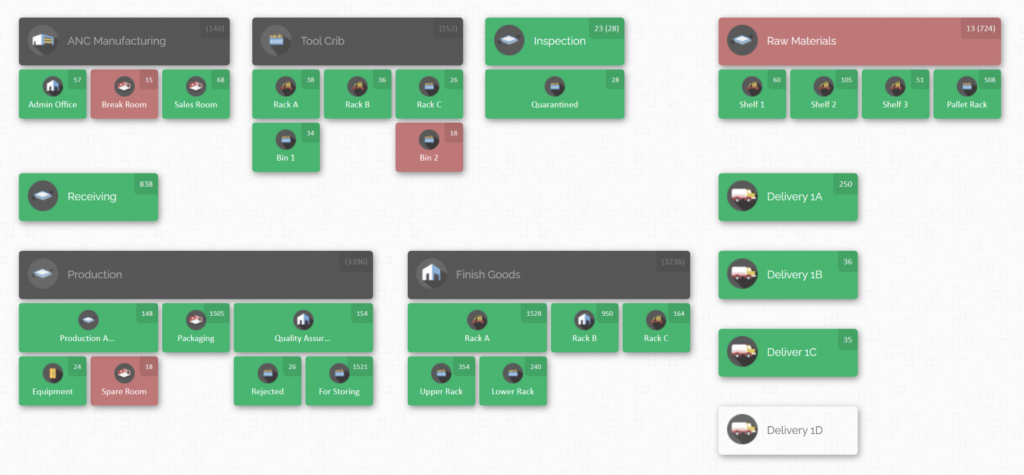
How Inventory Mapping Enhances Inventory Management in the Manufacturing Industry
Managing inventory in the manufacturing industry can be a complex and daunting task. Traditional methods often fall short, leading to inefficiencies, errors, and increased costs. Enter inventory mapping—a game-changer for inventory management. With its visual, real-time representation of inventory locations and levels, inventory mapping is revolutionizing the way manufacturers handle their stock.
Inventory Mapping in Manufacturing
Let’s start with the basics: what exactly is inventory mapping? At its core, inventory mapping involves creating a visual representation of inventory locations and levels within a warehouse or manufacturing facility. Imagine having a detailed map that shows you exactly where each item is located and how much stock you have at any given time. That’s inventory mapping.
Inventory mapping involves creating a detailed visual representation of where all inventory items are located within a warehouse or manufacturing facility. This allows for easy identification and tracking of inventory.
What are the components of Inventory Mapping?
- Visual Representations / Visual Inventory Map – Digital floor plans showcasing the exact locations of all inventory items.
- Real-Time Tracking – Continuous updates on inventory levels and movements, giving you up-to-the-minute data. It avoids human error and discrepancies in numbers reflected in different departments’ records.
- Location Management – Organizing inventory into zones, bins, or shelves for easy location and retrieval.
How does it work?
Implementing inventory mapping involves a few key steps:
- Creating a visual inventory map: Create a warehouse or manufacturing facility map. This could be as simple as a floor plan.
- Tagging Inventory Items: Use barcodes or RFID tags to mark each item. This step is crucial for tracking.
- Integrating with Inventory Management System: Connect the mapping system with your existing inventory management processes.
- Training Staff: Ensure all relevant personnel are trained on the new system. A system is only as good as the people using it.
Challenges in Inventory Management for Manufacturing
Manufacturing inventory is a beast of its own. Unlike retail, where you deal mostly with finished products, manufacturing involves raw materials, components, subassemblies, and finished goods. Each category has its own set of complexities and managing them all simultaneously can be a logistical nightmare.
Complexity of Manufacturing Inventory
Manufacturers often deal with a wide variety of inventory items, including raw materials, components, and finished goods. Managing these different types of inventory can be complex and time-consuming.
Traditional systems often rely on manual tracking, which is prone to errors and inefficiencies. Imagine manually counting thousands of components and then inputting that data into a system. It’s not only time-consuming but also prone to human error. Plus, traditional systems lack real-time data, meaning you’re always playing catch-up with your inventory levels.
Impact on Production and Cost
Poor inventory management can have a ripple effect on your entire operation. Delays in production, stockouts, overstocking, and increased operational costs are just a few of the issues that can arise. These problems can halt production, lead to missed deadlines, and inflate costs, ultimately affecting your bottom line.
The Importance of Inventory Visibility in Manufacturing

For manufacturers, clear and real-time visibility into inventory is crucial. It helps you respond quickly to changes in demand, optimize stock levels, and reduce carrying costs. In other words, it helps you stay agile and competitive in a fast-paced market.
Inventory visibility refers to the ability to track and monitor inventory levels and locations in real-time.Knowing what product or item is located where. This transparency is essential for efficient inventory management. High inventory visibility allows manufacturers to ensure accurate stock levels, improve production planning, and make better decisions. When you can see exactly what you have, where it is, and how much you need, managing inventory becomes significantly easier.
Having clear and real-time visibility into inventory is crucial for operational success. It helps manufacturers respond quickly to changes in demand, optimize stock levels, and reduce carrying costs. In other words, it helps you stay agile and competitive in a fast-paced market.
How Inventory Mapping Enhances Inventory Visibility

Inventory mapping takes transparency to a whole new level. With a visual representation of your inventory locations and levels, you can see exactly where each item is stored. This makes it much easier to manage your inventory and reduce the time spent searching for items.
Enhanced Transparency
Inventory mapping offers a detailed, visual layout of inventory locations and levels, making it easier to see exactly where items are stored. This transparency eliminates guesswork and ensures that you have a precise understanding of your inventory at all times. Whether you’re looking at raw materials, work-in-progress items, or finished goods, inventory mapping provides a clear snapshot of your stock, facilitating better organization and management.
Real-Time Updates
Real-time updates are truly transformative for inventory management. They ensure that your inventory data is always up-to-date, enabling you to make informed decisions quickly. This means no more relying on outdated information or making guesses about stock levels. Instead, you have current data at your fingertips, allowing for rapid response to changes in inventory, such as sudden demand spikes or supply chain disruptions.
Comprehensive Overview
Inventory mapping offers a holistic view of all your inventory across multiple locations. Whether you operate a single warehouse or a network of facilities, you can monitor inventory movements and levels in real-time. This comprehensive overview not only enhances management and coordination but also improves accountability by tracking inventory movements throughout the manufacturing process. It allows for better oversight and control, ensuring that all parts of the inventory system are aligned and functioning efficiently.
Improved Decision-Making
With accurate visibility provided by inventory mapping, managers can make more informed decisions regarding production planning, procurement, and logistics. This level of insight helps optimize resources, ensuring that you purchase the right amount of materials, schedule production runs effectively, and streamline logistics operations. Improved decision-making ultimately leads to increased efficiency and cost savings, as you can better align inventory levels with actual demand.
Reduced Errors and Discrepancies
Errors and discrepancies in inventory records can be costly, leading to production delays and financial losses. Inventory mapping helps identify and rectify these issues quickly by providing precise, real-time data. With enhanced visibility, you can spot discrepancies between physical stock and recorded inventory immediately, allowing for prompt corrections. This accuracy reduces the risk of costly mistakes and ensures that your inventory records are reliable.
Better Production Planning
Clear visibility of materials for production runs is essential for minimizing downtime and optimizing production schedules. Inventory mapping provides detailed insights into the availability of materials, ensuring that you have the right components in the right quantities at the right time. This foresight helps avoid production halts due to missing materials and allows for more efficient planning and execution of manufacturing processes. With better production planning, you can improve lead times, meet customer demands more effectively, and enhance overall productivity.
Overcoming Common Implementation Challenges
Implementing inventory mapping comes with its own set of challenges, but with the right approach, these can be effectively managed. Here’s how to tackle them.
- Identifying the Right Software:
- Choosing the right inventory mapping software is crucial. Look for a solution that meets your specific needs and integrates seamlessly with your existing systems. Evaluate different options, check reviews, and consider a trial period before making a decision.
- Integration with Inventory and Manufacturing Processes
- Integrating inventory mapping tools with your current inventory processes is essential for consistency. Ensure compatibility to avoid discrepancies and ensure smooth operations.
- Staff Training
- Training employees and securing their buy-in for the new system is essential. Provide comprehensive training sessions and highlight the benefits of the new system to encourage adoption. A motivated and well-informed team is key to successful implementation.
- Dealing with Data Migration
- Effectively migrating existing inventory data to the new system is critical. Plan the migration process carefully, ensuring data accuracy and integrity. Conduct thorough testing before going live to avoid any disruptions.
- Ensuring Ongoing Support
- Continuous support and updates from the software provider are important for the long-term success of the inventory mapping system. Choose a provider that offers reliable support, regular updates, and is responsive to your needs.
Conclusion
Inventory mapping is a powerful tool that can transform inventory management in the manufacturing industry. By providing enhanced visibility, real-time updates, and comprehensive overviews, inventory mapping helps manufacturers optimize their inventory levels, improve efficiency, and reduce costs. Implementing inventory mapping requires careful planning, the right software, and effective training, but the benefits far outweigh the challenges. Manufacturers looking to improve their inventory management should consider adopting inventory mapping to stay competitive and achieve operational excellence.
Integrating Creative Solutions for Robust Inventory Systems
At VisualFizz, we believe that technology and creativity go hand in hand. For manufacturing clients, our team crafts bespoke digital experiences that make inventory management systems more intuitive and user-friendly. From designing interactive digital dashboards that provide real-time inventory insights to developing custom mobile apps for on-the-go inventory tracking, our solutions are tailored to enhance both the efficiency and the user experience of inventory management systems.
Enhancing Inventory Management with Strategic Digital Marketing
Inventory management in the manufacturing sector reaches new heights when paired with strategic digital marketing. VisualFizz excels in creating personalized digital marketing plans that align closely with operational needs. By integrating inventory mapping technologies with our SEO and content marketing services, we help manufacturers not only maintain optimal inventory levels but also ensure that their products reach the target audience effectively. This dual approach not only streamlines operations but also boosts online visibility and customer engagement.
Guest Author Bio:
Claude Rivera is a Channel Manager at CyberStockroom, where she specializes in empowering businesses to overcome the challenges of field inventory management through innovative software solutions. With a keen focus on the needs of companies managing field inventory, Claude and her team offer a robust SaaS platform designed to simplify and streamline inventory processes. Her dedication to aiding inventory managers and business owners comes from a deep understanding of the operational hassles they face daily. For more insights into improving your inventory management practices, visit CyberStockroom.
Publishing Date:







